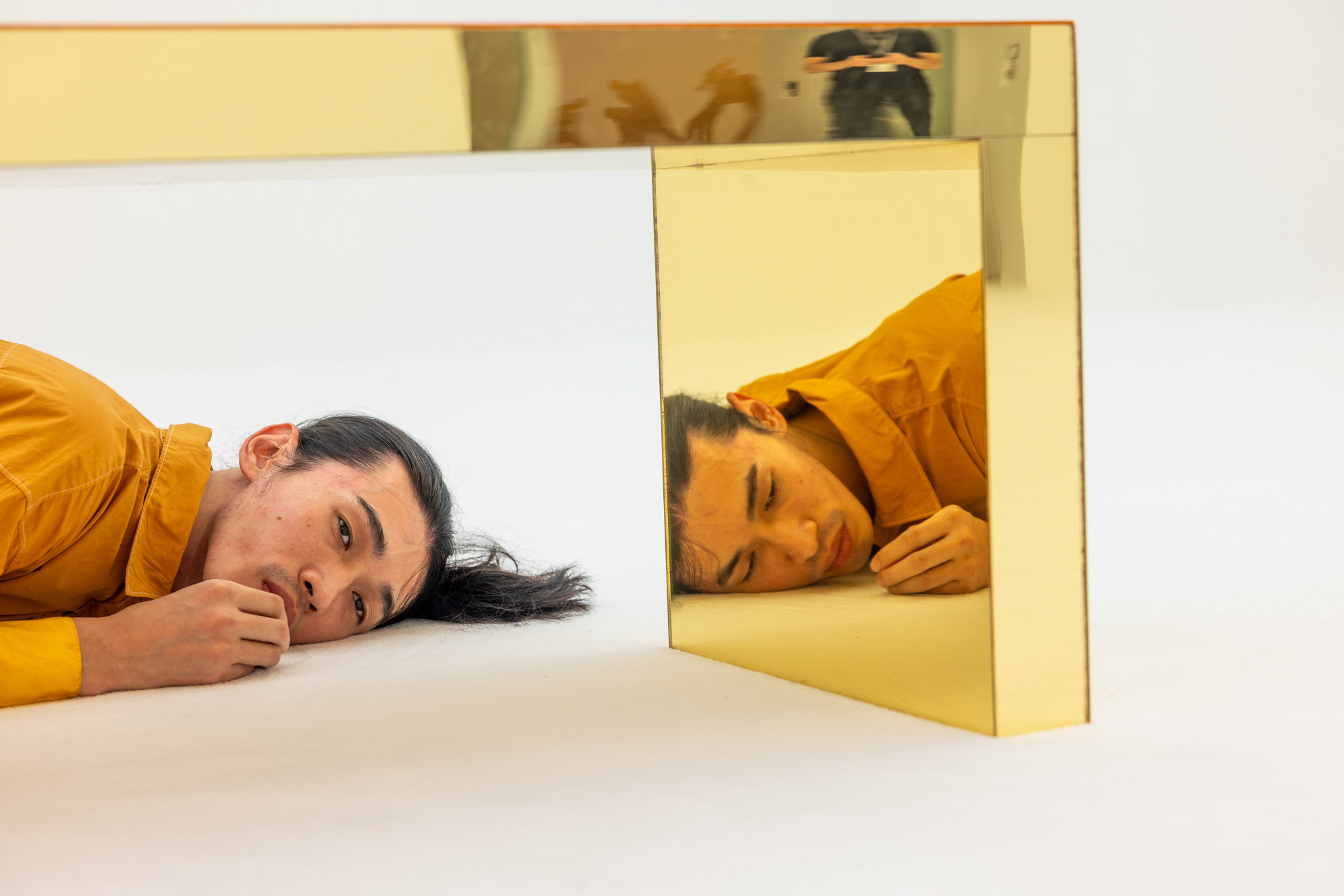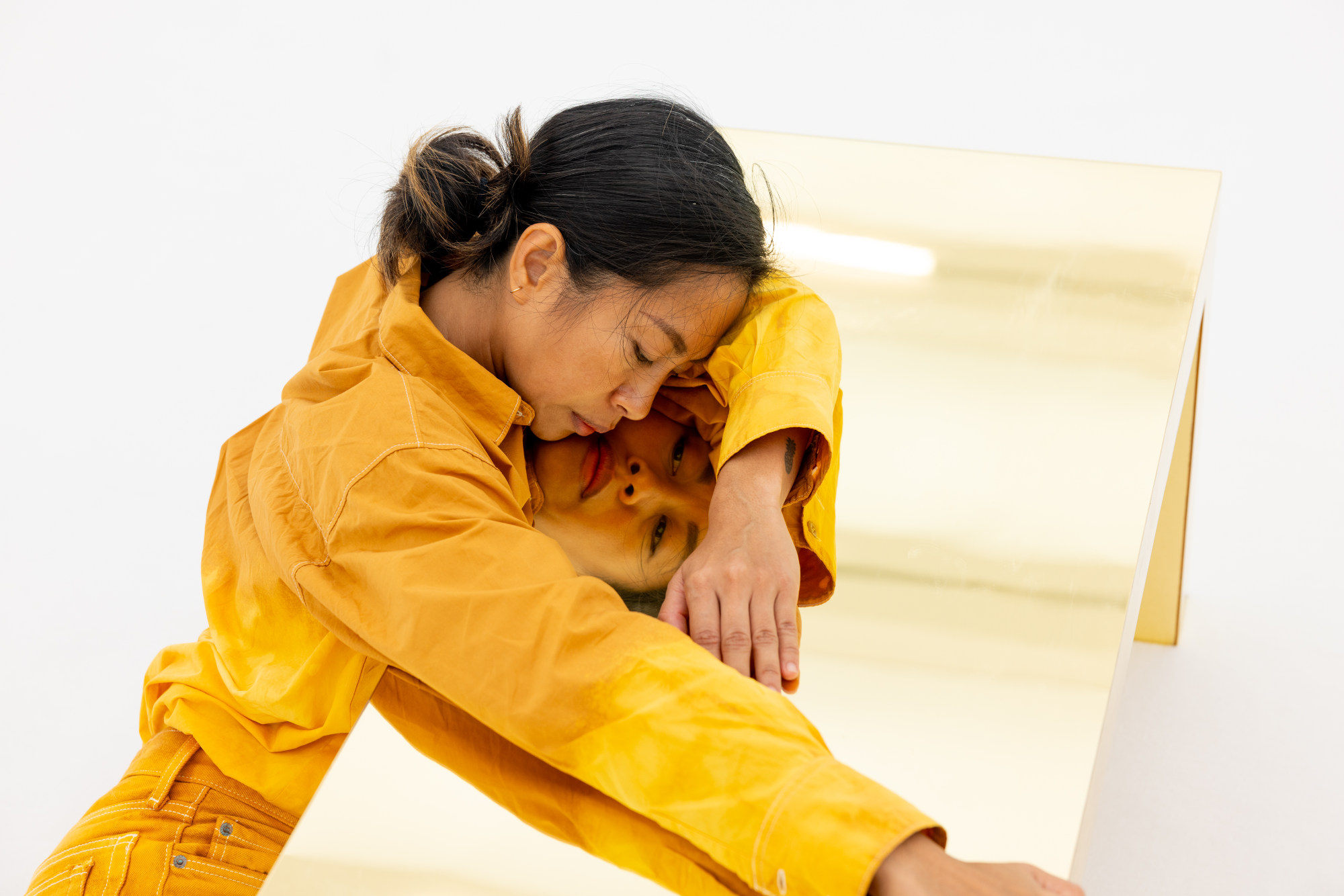
Live performance art show at Hong Kong’s Tai Kwun centre sees time seemingly slow in Maria Hassabi’s meticulously choreographed dance routine
- Maria Hassabi’s ‘I’ll Be Your Mirror’ – the first solo presentation in Asia from one of live art’s leading figures – features two contrasting installations
- The deceleration of time can be viewed as a critique of the rapid pace of daily life, especially in Hong Kong, one of the co-curators says
Clad in a mustard yellow jumpsuit, a dancer painstakingly warps her body around a gold mirrored bench in the middle of Tai Kwun’s JC Contemporary exhibition space in Central.
She moves at a snail’s pace, pausing once every few seconds, as part of a meticulously choreographed routine that seems to decelerate time for the audience.
Titled White Out, this live installation is being shown as part of “I’ll Be Your Mirror”, Maria Hassabi’s first solo presentation in Asia.
Having exhibited at the Venice Biennale in 2013 and New York’s Museum of Modern Art in 2016, among other institutions and museums, the Cyprus-born, New York-based artist is known as a leading figure of live art, a discipline in which the body is displayed as a living sculpture in museums, theatres and public spaces.

“Maria is one the most important and active artists who is doing live work in museums and biennale settings,” says Xue Tan, senior curator at Tai Kwun Contemporary, who curated “I’ll Be Your Mirror” with Louiza Ho.
“As a young and vibrant art centre in Hong Kong, we wanted to bring something that’s different from [typical] collections that could activate the museum space.”
Artists bare intimate personal memories on Hong Kong’s most public stage
For Hassabi, whose first collaboration with Tai Kwun was for the 2021 group exhibition “Trust & Confusion”, the body has always been a source of curiosity and a vessel for communication.
“We all have a body that we function with, that we carry around with us. The body holds a lot of secrets,” she says. “At the end of the day, I’m interested in humanity, so using the body is a way to come closer to the viewer.”
“I’ll Be Your Mirror” features two live installations, the first of which is White Out.

Here, all four walls have been painted bright white and the floor is covered in white carpeting – a reference to the “white cube” aesthetic typically seen in galleries. One dancer takes centre stage amid a gold bench and other mirrored gold blocks.
The second installation is I’ll Be Your Mirror. In this smaller room, the golden mirrored walls and flooring are crammed with reflections of the audience and the lone dancer, a dramatic reversal of the blankness of the previous room.
The idea is for the audience to experience that shift of perception for themselves – a change that opens up possibilities in the body’s relationship with space and time, Hassabi says.

It helps to spend a fair amount of time in the rooms so that you can watch the dancers – working in two-hour shifts – perform a choreographed routine of deliberately slow, precise movements that is bookended by pauses at consistent intervals.
“I keep the rhythm quite even, so there’s no accents in the movement,” Hassabi says. “Once there’s accents, importance becomes an issue. Importance makes hierarchy, which I’m not interested in.”
Tan says that this deceleration of time can be viewed as a critique of the rapid pace of daily life.
“Especially in Hong Kong, life is so fast-paced, accelerated. Maria’s work is the opposite of what our society [expects],” she says. “It’s about deceleration … Fast does not mean progress.”

There is no barrier between the viewers and the dancers, which prompts the question of whether the audience are also performers, as they can’t avoid looking at each other as well as the dancers.
“The dancers are there by themselves, completely unprotected. There is no stage,” Tan says. “The audience is in the work, they are in the same time and place, and they can get as close as they want to the dancers.
“That is a very generous and open [approach]. It’s quite profound, that vulnerability.”

Hassabi also welcomes visitors to take photos of the installations.
“Her work has been circulated so much online, and she feels that’s part of how the work transmits,” Tan says. “She plays with it. When one takes a photo in the space, inevitably, you capture other visitors, and they are part of the work.”
Hassabi explains that the use of gold has to do with the unique values that are associated with the metal.
“Gold is so kitsch. It’s a symbol of power, but in a very particular way,” Hassabi says.

It is also full of contradictions, she adds – gold can represent the divine, but also corruption; it is malleable, but also enduring.
“When the Twin Towers fell in New York, it really made a huge impression to me that one of the only things that didn’t get destroyed was the gold bars from the bank that were on the ground floor,” she says.
The durability of gold is the opposite of the temporal nature of dance, she says. “A dancer, and dancing in general, evaporates through time.”

Tan believes that Hassabi’s works – and the live-performance-art movement in general – have completely changed the world’s perception of how art can be presented and consumed.
“It’s an unusual show for Hong Kong – it’s incredibly innovative. It really takes people in, and we see how the audience changes completely the moment they step into the room. This is so different from visiting any other visual-arts exhibitions,” she says.
“It’s very stimulating, and it brings [out] our sensitivity and empathy to others. And I think that’s incredibly important for the times we are living in.”
“I’ll Be Your Mirror”, JC Contemporary, Tai Kwun, 10 Hollywood Road, Central, Tue-Sun, 11am to 7pm. Until November 26.

